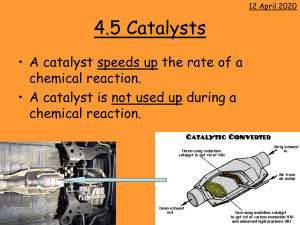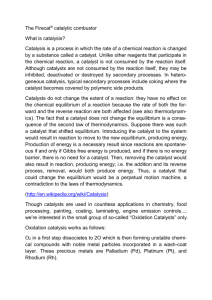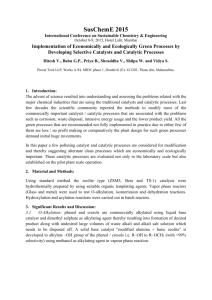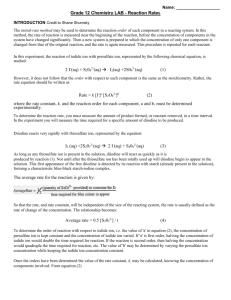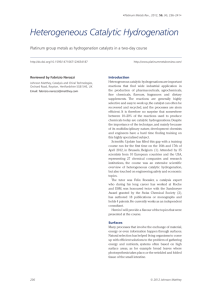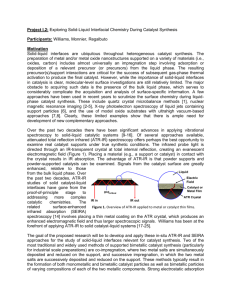TRANSITION METALS AS CATALYSTS
advertisement
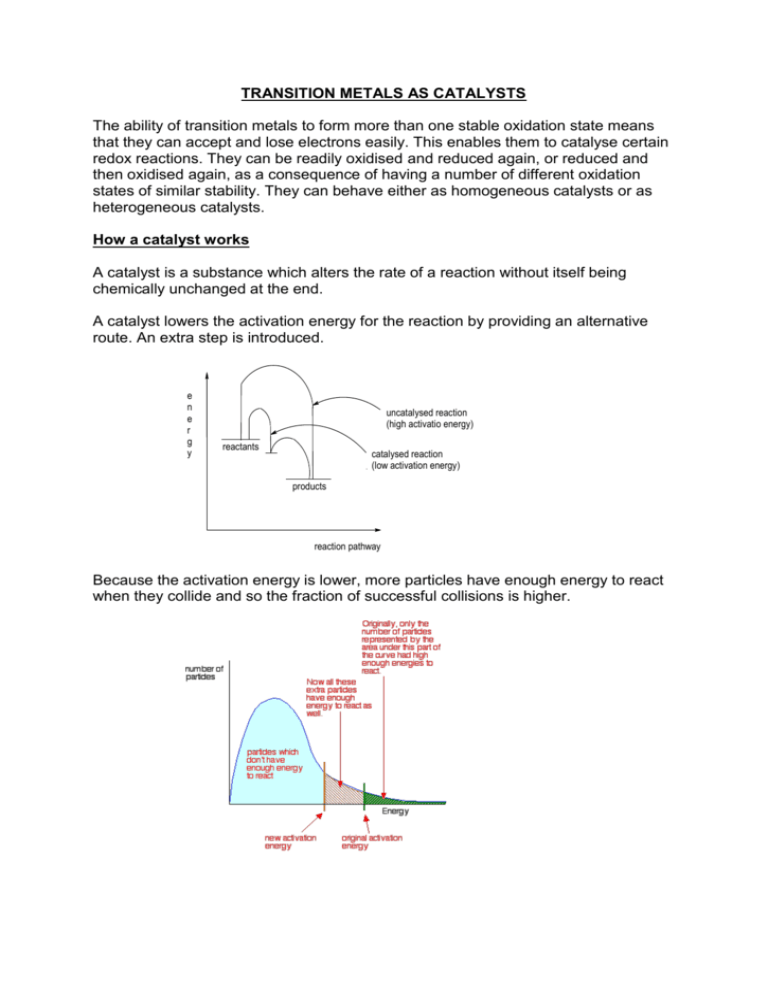
TRANSITION METALS AS CATALYSTS The ability of transition metals to form more than one stable oxidation state means that they can accept and lose electrons easily. This enables them to catalyse certain redox reactions. They can be readily oxidised and reduced again, or reduced and then oxidised again, as a consequence of having a number of different oxidation states of similar stability. They can behave either as homogeneous catalysts or as heterogeneous catalysts. How a catalyst works A catalyst is a substance which alters the rate of a reaction without itself being chemically unchanged at the end. A catalyst lowers the activation energy for the reaction by providing an alternative route. An extra step is introduced. e n e r g y uncatalysed reaction (high activatio energy) reactants catalysed reaction (low activation energy) products reaction pathway Because the activation energy is lower, more particles have enough energy to react when they collide and so the fraction of successful collisions is higher. 1. Homogeneous catalysis A homogeneous catalyst is a catalyst in the same phase as the reactants. Homogeneous catalysis involves aqueous transition metal ions catalysing reactions, often between two anions. The cation reacts with each anion in turn, thus avoiding the need for a direct collision between two anions (this is difficult since they repel each other). Eg 1 S2O82-(aq) + 2I-(aq) 2SO42-(aq) + I2(aq) This can be catalysed by Fe2+ or Fe3+ ions: With Fe2+: S2O82-(aq) + 2Fe2+(aq) 2SO42-(aq) + 2Fe3+(aq) 2Fe3+(aq) + 2I-(aq) 2Fe2+(aq) + I2(aq) With Fe3+: 2Fe3+(aq) + 2I-(aq) 2Fe2+(aq) + I2(aq) 2Fe2+(aq) + S2O82-(aq) 2Fe3+(aq) + 2SO42-(aq) Eg 2 2MnO4-(aq) + 5C2O42-(aq) + 16H+(aq) 2Mn2+(aq) + 10CO2(g) + 8H2O(l) This is a good example of auto-catalysis. One of the products in this reaction, Mn2+(aq), behaves as a catalyst and thus the reaction is slow at first but is much faster after a little of the products are formed. 2. Heterogeneous catalysis A heterogenous catalyst is a catalyst in a different phase that the phase of the reactants Heterogeneous catalysts react by allowing the reactant molecules to bond to the surface of the metal, usually by attracting the surface electrons. The reaction takes place at the surface, and the transition metal regains electrons as the products leave. The reaction is catalysed because the reactant molecules spend more time in contact with each other than they would in the absence of a catalyst. Eg hydrogenation of ethene H H C C H H H H H H H C Ni C H H H H H Ni H H C H C Ni H Other Points To Consider a) physical adsorption and chemisorption The molecules usually bond to the surface of the metal using intermolecular forces such as Van der Waal’s forces. This is known as physical adsorption. Sometimes they actually form a covalent bond with the metal. This is known as chemisorption. An ideal heterogeneous catalyst adsorbs fairly strongly but not too strongly. If it adsorbs too weakly (like silver) the reactant molecules do not spend enough time in contact with each other. If they adsorb too strongly (like tungsten) the products do not leave the metal surface quickly enough and this slows the reaction down. The most useful catalysts are those which adsorb moderately. As the strength of absorption tends to decrease fro left to right along the Periodic Table, the most effective catalysts tend to be the transition metals in the middle, like V, Fe and Ni. b) examples of heterogeneous catalysts Examples of heterogenous catalysts are; Fe in the production of ammonia, V 2O5 in the contact process and Pt or Ni in the hydrogenation of ethene. i) N2(g) + 3H2(g) == 2NH3(g) Fe catalyst ii) 2SO2(g) + O2(g) == 2SO3(g) iii) C2H4(g) + H2(g) == C2H6(g) iv) 2CO(g) + 2NO(g) == N2(g) + 2CO2(g) Rh catalyst The catalytic converter converts toxic carbon monoxide and nitrogen monoxide to non-toxic carbon dioxide and nitrogen. c) surface area V2O5 catalyst Pt/Ni catalyst The catalyst needs to have a large surface area to be effective. This means it needs to be very thinly spread out, and might need a special support. Catalytic converters in cars use rhodium (Rh) on a special ceramic support d) catalyst poisoning Heterogeneous catalysts can be poisoned by impurities, which are often present in the raw materials used. These impurities bond very strongly to the catalyst surface and block it. The activity of iron in the Haber process is reduced by sulphur, present in iron as an impurity so it is essential that as much sulphur as possible is removed during the Basic Oxygen Process. The efficiency of catalytic converters in cars is reduced by lead, which bonds permanently to the rhodium surface. This has lead to the increased use of unleaded petrol.

